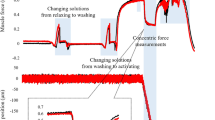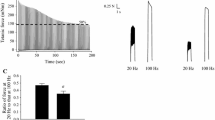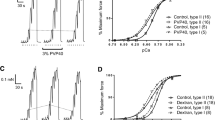Summary
The role of orthophosphate (Pi) ions in crossbridge kinetics was investigated in chemically skinned rabbit psoas fibres in the presence of saturating Ca2+. The muscle length was altered sinusoidally, and the resulting tension time courses were analysed in terms of three exponential processes (A), (B) and (C). Experiments were also performed with step length changes, and the resulting tension transients were correlated with the results of sinusoidal analysis. It was shown that addition of a low millimolar concentration of Pi increased both the rate constant and magnitude of process (B), which resulted in a dramatic increase in the oscillatory power output. The Pi effect was greater at higher oscillation amplitude and at higher MgATP concentration. At 5mm MgATP, the amplitude effect became saturated at a 6 nm length change per crossbridge, whereas the Pi effect did not become saturated in the concentration range tested (0–16mm), An introduction of MgADP to the activating saline resulted in a decrease of all rate constants, and these effects were opposite to MgATP. The effect of Pi resembled neither MgADP nor MgATP. Based on these observations, all the crossbridge reactions except for one (ADP desorption reaction) were eliminated as the possible site of action of Pi ions, supposing that Pi affects only one specific site in the crossbridge cycle. Other mechanisms, which might account for the Pi effects, are the presence of parallel hydrolysis pathways and the presence of multiple sites of action of the Pi ions.
Similar content being viewed by others
References
Abbott, R. H. &Mannherz, H. G. (1970) The activation by ADP and temperature increase of tension and ATPase activity of insect fibrillar muscle.Pflügers Arch. 321, 223–32.
Bagshaw, C. R. &Trentham, D. R. (1974) The characterization of myosin-product complexes and of product-release steps during the magnesium iondependent adenosine triphosphatase reaction.Biochem. J. 141, 331–49.
Brandt, P. W., Cox, R. N., Kawai, M. &Robinson, T. (1982) Regulation of tension in skinned muscle fibres: effect of cross-bridge rate constants on apparent Ca sensitivity.J. gen. Physiol. 79, 997–1016.
Cox, R. N. &Kawai, M. (1981) Alternate energy transduction routes in chemically skinned rabbit psoas muscle fibres: a further study of the effect of MgATP over a wide concentration range.J. Musc. Res. Cell Motility 2, 203–14.
Ferenczi, M. A., Simmons, R. M. &Sleep, J. A. (1982) General considerations of cross-bridge model in relation to the dependence on MgATP concentration of mechanical parameters of skinned fibers from frog muscle. InBasic Biology of Muscles: A Comparative Approach (edited byTwarog, B. M., Levine, R. J. C. andDewey, M. M.), pp. 109–30. New York: Raven Press.
Gillis, J. M. &Maréchal, G. (1974) The incorporation of radioactive phosphate into ATP in glycerinated fibers stretched or released during contraction.J. Mechanochem. Cell Motility 3, 55–68.
Goldman, Y. E., Hibberd, M. G., McCray, J. A. &Trentham, D. R. (1982) Relaxation of muscle fibres by photolysis of caged ATP.Nature, Lond. 300, 701–5.
Goldman, Y. E., Hibberd, M. G. &Trentham, D, R. (1984) Initiation of active contraction by photogeneration of adenosine-5′-triphosphate in rabbit psoas muscle fibres.J. Physiol., Lond. 354, 605–24.
Heinl, P., Kuhn, H. J. &Rüegg, J. C. (1974) Tension responses to quick length changes of glycerinated skeletal muscle fibres from the frog and tortoise.J. Physiol., Lond. 237, 243–58.
Herzig, J. W. &Rüegg, J. C. (1977) Myocardial cross-bridge activity and its regulation by Ca2+, phosphate and stretch. InMyocardial Failure (edited byRiecker, G., Weber, A. andGoodwin, J.), pp. 41–51. New York: Springer-Verlag.
Herzig, J. W., Peterson, J. W., Solaro, R. J. &Rüegg, J. C. (1982) Phosphate and vanadate reduce the efficiency of the chemo-mechanical energy transformation in cardiac muscle. InRegulation of Phosphate and Mineral Metabolism (edited byMassry, S. G., Letteri, J. M. andRitz, E.), pp. 267–81. New York: Plenum Publishing.
Hibberd, M. G., Danzig, J. A., Trentham, D. R. &Goldman, Y. E. (1985) Phosphate release and force generation in skeletal muscle fibers.Science, N. Y. 228, 1317–19.
Huxley, A. F. (1974) Muscular contraction.J. Physiol., Lond. 243, 1–43.
Huxley, A. F. &Simmons, R. M. (1971) Proposed mechanism of force generation in striated muscle.Nature, Lond.,233, 533–38.
Kawai, M. (1978) Head rotation or dissociation? A study of exponential rate processes in chemically skinned rabbit muscle fibers when MgATP concentration is changed.Biophys. J. 22, 97–103.
Kawai, M. (1979) Effect of MgATP on cross-bridge kinetics in chemically skinned rabbit psoas fibers as measured by sinusoidal analysis technique. InCross-bridge Mechanism in Muscle Contraction (edited bySugi, H. andPollack, G. H.), pp. 149–69. Tokyo: University of Tokyo Press.
Kawai, M. (1982) Correlation between exponential processes and crossbridge kinetics. InBasic Biology of Muscles: A Comparative Approach (edited byTwarog, B. M., Levine, R. J. C. andDewey, M. M.), pp. 109–30. New York: Raven Press.
Kawai, M. &Brandt, P. W. (1976) Two rigor states in skinned crayfish single muscle fibers.J. gen. Physiol. 68, 267–80.
Kawai, M. &Brandt, P. W. (1977) Effect of MgATP on stiffness measured at two frequencies in Ca activated muscle fibers.Proc. natn. Acad. Sci. U.S.A. 74, 4073–5.
Kawai, M. &Brandt, P. W. (1978) Effect of pH on oscillatory work and tension in skinned rabbit muscles.Biophys. J. 21, 86a.
Kawai, M. &Brandt, P. W. (1980) Sinusoidal analysis; a high resolution method for correlating biochemical reactions with physiological processes in activated skeletal muscles of rabbit, frog and crayfish.J. Musc. Res. Cell Motility 1, 279–303.
Kawai, M. &Schulman, M. I. (1985) Crossbridge kinetics in chemically skinned rabbit psoas fibres when the actin-myosin lattice spacing is altered by dextran T-500.J. Musc. Res. Cell Motility 6, 312–32.
Kawai, M. &Orentlicher, M. (1976) Effect of inorganic phosphate, substrate, and excess ATP on complex stiffness of skinned crayfish muscle fibers and glycerinated rabbit psoas muscle bundles.Biophys. J. 16, 152a.
Kawai, M., Brandt, P. W. &Orentlicher, M. (1977) Dependence of energy transduction in intact skeletal muscles on the time in tension.Biophys. J. 18, 161–72.
Kawai, M., Cox, R. N. &Brandt, P. W. (1981) Effect of Ca ion concentration on cross-bridge kinetics in rabbit psoas fibers. Evidence for the presence of two Ca-activated states of thin filament.Biophys. J. 35, 375–84.
Kawai, M., Wolen, C. &Cornacchia, T. (1985) The effect of phosphate (Pi) on crossbridge kinetics in psoas fibers indicates that the forward cycling rate increases with Pi.Biophys. J. 47, 24a.
Lienhard, G. E. &Secemski, I. I. (1973) P1,P5-Di(adenosine-5′)pentaphosphate, a potent multisubstrate inhibitor of adenylate kinase.J. biol. Chem. 248, 1121–3.
Lymn, R. W. &Taylor, E. W. (1971) The mechanism of adenosine triphosphate hydrolysis by actomyosin.Biochemistry 10, 4617–24.
Machin, K. E. (1964) Feedback theory and its application to biological systems.Symp. Soc. exp. Biol. 18, 421–45.
Pringle, J. W. S. (1967) The contractile mechanism of insect fibrillar muscle.Prog. Biophys. Mol. Biol. 17, 1–60.
Pybus, J. &Tregear, R. T. (1975) The relationship of adenosine triphosphatase activity to tension and power output of insect flight muscle.J. Physiol., Lond. 247, 71–89.
Rüegg, J. C. &Tregear, R. T. (1966) Mechanical factors affecting the ATPase activity of glycerol-extracted fibers of insect fibrillar flight muscle.Proc. Roy. Soc. Ser. B 165, 497–512.
Rüegg, J. C., Schadler, M., Steiger, G. J. &Muller, G. (1971) Effects of inorganic phosphate on the contractile mechanism.Pflügers Arch. 325, 359–64.
Sleep, J. A. &Hutton, R. L. (1980) Exchange between inorganic phosphate and adenosine 5′-triphosphate in the medium by actomyosin subfragment 1.Biochemistry 19, 1276–83.
Steiger, G. J. &Rüegg, J. C. (1969) Energetics and ‘efficiency’ in the isolated contractile machinery of an insect fibrillar muscle at various frequencies of oscillation.Pflügers Arch. 307, 1–21.
Stein, L. A., Schwarz, R. P., Chock, P. B. &Eisenberg, E. (1979) Mechanism of actomyosin adenosine triphosphatase. Evidence that adenosine 5′-triphosphate hydrolysis can occur without dissociation of the actomyosin complex.Biochemistry 18, 3895–909.
Tanaka, H. &Shimizu, H. (1984) Symmetric and asymmetric processes in the mechano-chemical conversion in the cross-bridge mechanism studied by isometric tension transients. InContractile Mechanisms in Muscle (edited byPollack, G. H. andSugi, H.), pp. 585–99. New York: Plenum Press.
Taylor, E. W. (1979) Mechanism of actomyosin ATPase and the problem of muscle contraction.Crit. Rev. Biochem. 6, 103–64.
Tonomura, Y., Nakamura, H., Kinoshita, N., Onishi, H. &Shigekawa, M. (1969) The pre-steady state of the myosin-adenosine triphosphate system. X. The reaction mechanism of the myosin-ATP system and a molecular mechanism of muscle contraction.J. Biochem. 66, 599–618.
Ulbrich, M. &Rüegg, J. C. (1971) Stretch induced formation of ATP-32P in glycerinated fibres of insect flight muscle.Experientia 27, 45–6.
Ulbrich, M. &Rüegg, J. C. (1976) Is the chemomechanical energy transformation reversible?Pflügers Arch. 363, 219–22.
Ulbrich, M. &Rüegg, J. C. (1977) Mechanical factors affecting the ATP-phosphate exchange reaction of glycerinated insect fibrillar muscle. InInsect Flight Muscle (edited byTregear, R. T.), pp. 317–33, Amsterdam: North Holland Publishing.
White, H. D. &Taylor, E. W. (1976) Energetics and mechanism of actomyosin adenosine triphosphatase.Biochemistry 15, 5818–26.
White, D. C. S. &Thorson, J. (1972) Phosphate starvation and the non-linear dynamics of insect fibrillar flight muscle.J. gen. Physiol. 60, 307–36.
Author information
Authors and Affiliations
Rights and permissions
About this article
Cite this article
Kawai, M. The role of orthophosphate in crossbridge kinetics in chemically skinned rabbit psoas fibres as detected with sinusoidal and step length alterations. J Muscle Res Cell Motil 7, 421–434 (1986). https://doi.org/10.1007/BF01753585
Received:
Revised:
Issue Date:
DOI: https://doi.org/10.1007/BF01753585




